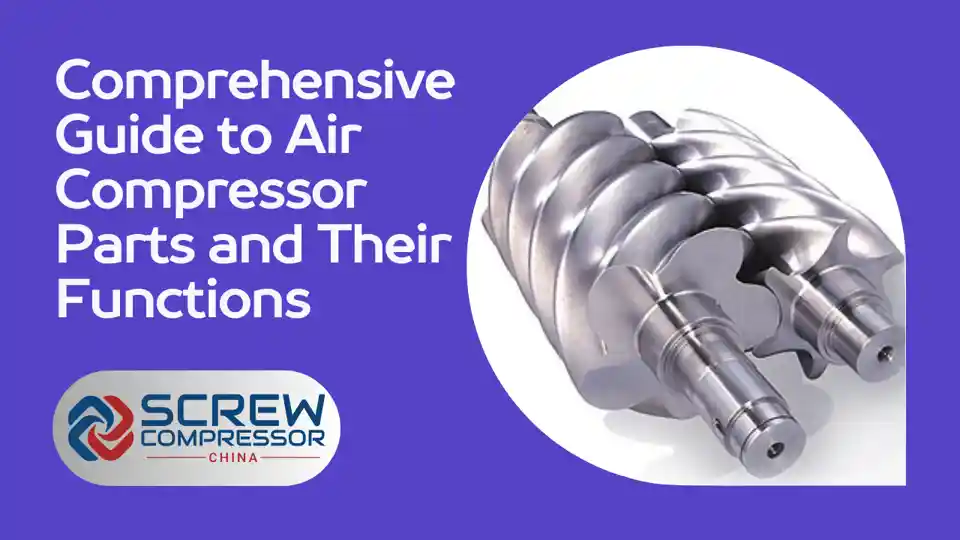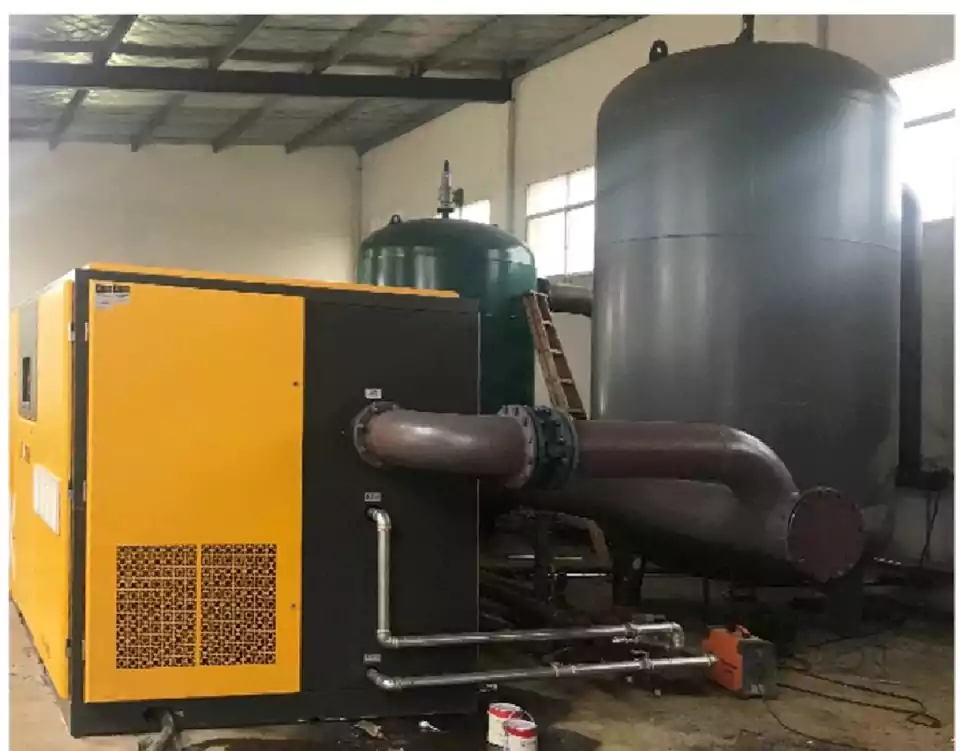
Understanding the intricate details of air compressor parts is crucial for maintaining your equipment’s efficiency and longevity. This comprehensive guide to compressed air systems provides a deep dive into the various components of air compressors, from diagrams to maintenance tips, helping you to optimize your system’s performance.
Air Compressor Anatomy Explained
![]()
The anatomy of an air compressor consists of several key components that work together to compress and deliver air efficiently. These components can be broadly categorized into the core compression system, the power source, and the auxiliary parts that support the compressor’s operation.
The core compression system is where the actual compression of air takes place. This includes the air end (for rotary screw compressors) or the compressor pump (for reciprocating compressors). The air end houses the rotors or screws that compress the air, while the compressor pump contains pistons that move within cylinders to compress the air.
The power source, typically an electric motor or a gas engine, drives the core compression system. The motor provides the necessary mechanical energy to turn the rotors or move the pistons, enabling the compression process.
Auxiliary components play a crucial role in ensuring the smooth and efficient operation of the air compressor. These include the air intake system, which filters the incoming air; the cooling system, which regulates the temperature of the compressed air and the compressor itself; and the lubrication system, which reduces friction and wear on moving parts.
Understanding how these components work together is essential for proper maintenance and troubleshooting. By familiarizing yourself with the anatomy of your air compressor, you can more easily identify potential issues and take appropriate action to keep your system running at peak performance.
Core Components of Air Compressors
Air compressors consist of several key components, each playing a pivotal role in air compression and system efficacy. Here, we delve into the essential parts of both rotary screw and reciprocating air compressors.
Rotary Screw Compressor Components
Rotary screw compressors are valued for their efficiency and continuous operation. The primary components include:
- Air End: The heart of the compressor where air gets compressed by the meshing of two helical screws. The air end consists of a pair of intermeshing rotors, one male and one female, that rotate in opposite directions. As the rotors turn, they trap air in the spaces between the lobes, gradually reducing the volume and increasing the pressure of the air as it moves through the air end. Learn more about the compression process from the Air Compressor Anatomy 101.
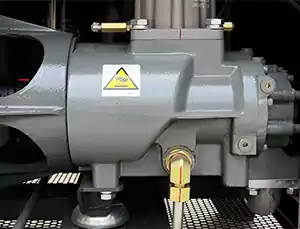
B&D Fixed Speed Rotary Screw Air Compressor – AIREND - Motor: Drives the air end and is critical for the energy efficiency of the system. The motor is typically an electric motor, although some compressors may use a gas engine. The size and efficiency of the motor directly impact the compressor’s performance and operating costs. High-efficiency motors can significantly reduce energy consumption and help lower utility bills.
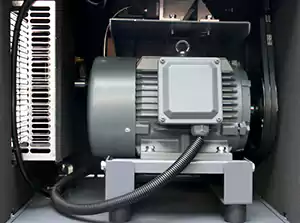
B&D Oil Free Scroll Air Compressor with Tank and Dryer – Motor - Cooling System: Maintains the temperature within safe limits during operation. Compressing air generates heat, and the cooling system is responsible for dissipating this heat to prevent damage to the compressor components. Cooling can be achieved through air cooling, where fins on the compressor body allow heat to dissipate into the surrounding air, or through liquid cooling, where a coolant is circulated through the compressor to absorb and remove heat.
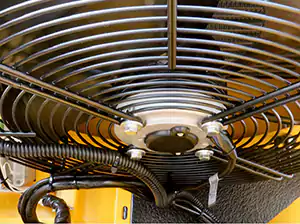
B&D PM Variable Speed Drive (VSD) Rotary Screw Air Compressor – fan
Reciprocating Compressor Components
These compressors utilize a piston mechanism for compressing air and include:
- Compressor Pump: Comprises a piston, cylinder, and valves to facilitate air compression. The piston moves up and down within the cylinder, drawing air in on the downstroke and compressing it on the upstroke. Valves control the flow of air into and out of the cylinder. Check out Parts Of An Air Compressor Diagram Guide for detailed diagrams.
- Motor: Provides the necessary power to operate the pump. As with rotary screw compressors, the motor can be electric or gas-powered. The motor turns a crankshaft, which converts the rotary motion into the reciprocating motion of the piston.
- Cooling System: Essential for heat regulation between compression stages. Reciprocating compressors often employ intercoolers, which are heat exchangers that cool the air between stages of compression. This improves efficiency and prevents overheating.
Supporting Air Compressor Parts
In addition to the core components, air compressors rely on several supporting parts to ensure smooth, safe, and efficient operation. These components work together to regulate pressure, remove contaminants, and protect the system from damage.
- Pressure Gauges: Monitor and display the pressure levels within the compressor. Pressure gauges allow operators to keep an eye on the system’s performance and make adjustments as needed. They are typically located on the air receiver tank and at various points throughout the compressed air distribution system.
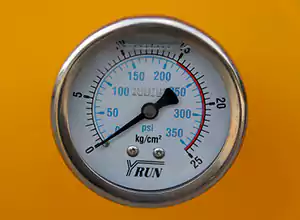
B&D Rotary Screw Air Compressor For Laser Cutting Machine – PRESSURE GAUGE - Filters and Separators: Keep the compressed air clean and the system running smoothly. Air filters remove particulates, dust, and other contaminants from the incoming air before it enters the compressor. Oil separators remove lubricating oil from the compressed air stream, ensuring that the air delivered to tools and equipment is clean and dry.
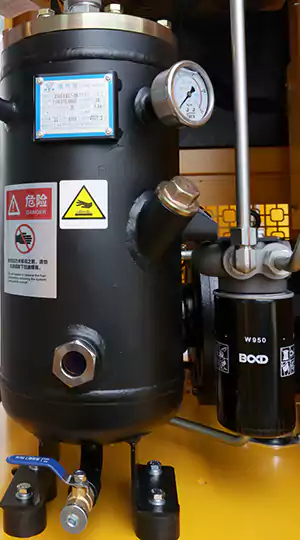
B&D Rotary Screw Air Compressor For Laser Cutting Machine – OIL SEPARATOR - Drain Valves: Remove condensation and prevent moisture buildup inside the compressor. As air is compressed, moisture in the air condenses and collects in the air receiver tank. Drain valves allow this condensate to be manually or automatically removed from the system, preventing corrosion and maintaining air quality.
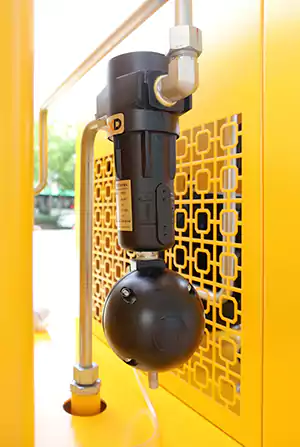
B&D Rotary Screw Air Compressor For Laser Cutting Machine – AUTOMATIC DRAINER - Safety Valves: Protect the compressor and operators from overpressure situations. Safety valves, also known as pressure relief valves, are designed to automatically open and release air if the pressure within the system exceeds a predetermined safe level. This prevents damage to the compressor and reduces the risk of accidents.
- Check Valves: Ensure that compressed air flows in the correct direction. Check valves allow air to flow in one direction but prevent backflow. They are often used at the discharge of the compressor to prevent compressed air from flowing back into the compressor when it is not running.
- Pressure Switches: Control the compressor’s operation based on system pressure. Pressure switches turn the compressor motor on when the pressure in the air receiver tank drops below a certain level and turn it off when the pressure reaches a predetermined upper limit. This helps maintain a consistent pressure range and prevents the compressor from running unnecessarily.
By understanding the role of each supporting component, you can more effectively maintain your air compressor and ensure that it operates safely and efficiently. Regular inspection and maintenance of these parts can help prevent downtime, extend the life of your compressor, and improve the quality of the compressed air delivered to your tools and equipment.
Maintenance and Troubleshooting
Proper maintenance is vital for the longevity and efficient operation of air compressors. Here are some expert tips and common troubleshooting solutions.
Routine Maintenance Tips
Regular maintenance tasks include:
- Checking and replacing the air filter: Ensures clean air intake and prevents damage. A clogged or dirty air filter can restrict airflow into the compressor, reducing efficiency and putting additional strain on the motor. Check the air filter regularly and replace it when it becomes visibly dirty or as recommended by the manufacturer.
- Inspecting and changing the oil: Crucial for lubricated systems to reduce wear and maintain performance. Check the oil level daily and top it off as needed. Change the oil and oil filter at the intervals specified in your compressor’s manual, or more frequently if the compressor is used in dusty or harsh conditions.
- Monitoring and adjusting belts: Prevents slippage and inefficiency. Over time, belts can stretch and lose tension, causing them to slip on the pulleys. This reduces power transmission efficiency and can lead to premature wear. Regularly inspect belts for cracks, fraying, or glazing, and adjust the tension as needed.
- Checking and cleaning the coolers: Maintains proper operating temperatures. Dirty or clogged coolers can lead to overheating, which can damage the compressor and shorten its lifespan. Regularly clean the cooler fins and tubes to ensure adequate heat dissipation.
- Draining the air receiver tank: Removes accumulated moisture and prevents corrosion. Moisture that condenses in the air receiver tank can lead to rust and reduce the tank’s structural integrity. Drain the tank daily or as recommended by the manufacturer to remove this moisture.
Troubleshooting Common Issues
Common issues might include unusual noise, overheating, or pressure fluctuations. Effective troubleshooting steps can often save on costly repairs.
- Unusual noise: Can indicate worn bearings, loose components, or insufficient lubrication. If you hear unusual squealing, grinding, or knocking sounds, shut down the compressor and investigate the cause. Tighten any loose bolts, check for worn bearings, and ensure that the compressor is properly lubricated.
- Overheating: Can be caused by clogged coolers, low oil levels, or a malfunctioning cooling fan. Clean the coolers, check the oil level and quality, and ensure that the cooling fan is operating correctly. If overheating persists, there may be an issue with the compressor’s internal components, and professional service may be required.
- Pressure fluctuations: Can result from air leaks, a malfunctioning pressure switch, or a damaged air end. Inspect the system for leaks and repair them as needed. Check the pressure switch for proper operation and adjust or replace it if necessary. If the issue persists, the air end may be damaged and require professional repair or replacement.
For a comprehensive parts list and troubleshooting tips, refer to Air Compressor Parts List.
Frequently Asked Questions
What are the signs that my air compressor needs maintenance?
Signs include increased noise levels, decreased efficiency, or visible wear and tear on parts. If you notice any of these signs, it’s time to perform routine maintenance or consult a professional for more complex issues.
How often should I replace the oil in my air compressor?
It depends on the type of compressor and usage frequency, but typically every 500-1000 hours of use. Refer to your compressor’s manual for specific recommendations, as some compressors may require more frequent oil changes based on their design or the operating conditions.
Can I perform maintenance on my air compressor myself?
Yes, basic maintenance like changing filters and oil is doable, but for more complex issues, consulting a professional is recommended. If you are unsure about any aspect of maintenance or troubleshooting, it’s always best to seek the advice of a qualified technician to avoid potential damage to your compressor or personal injury.
How can I extend the life of my air compressor?
Regular maintenance, proper usage, and storing the compressor in a clean, dry environment can help extend its life. Follow the manufacturer’s recommendations for maintenance intervals and operating procedures. Avoid running the compressor at pressures higher than its rated capacity, and ensure that the compressor has adequate ventilation to prevent overheating.
What should I do if my air compressor won’t start?
Check the power supply, pressure switch, and safety valves. Ensure that the compressor is properly plugged in and receiving power. Check the pressure switch for proper operation and adjust or replace it if necessary. Inspect the safety valves for any obstructions or damage. If these components are functioning correctly, there may be an issue with the motor or starter capacitor, which will require professional service.
Understanding and maintaining the various parts of an air compressor ensures its efficiency and prolongs its life. Whether it’s replacing a worn-out filter or consulting a detailed diagram to understand your system better, taking care of your air compressor is essential for optimal performance. For more detailed diagrams and professional insights, view Diagram of Air Compressor Parts.
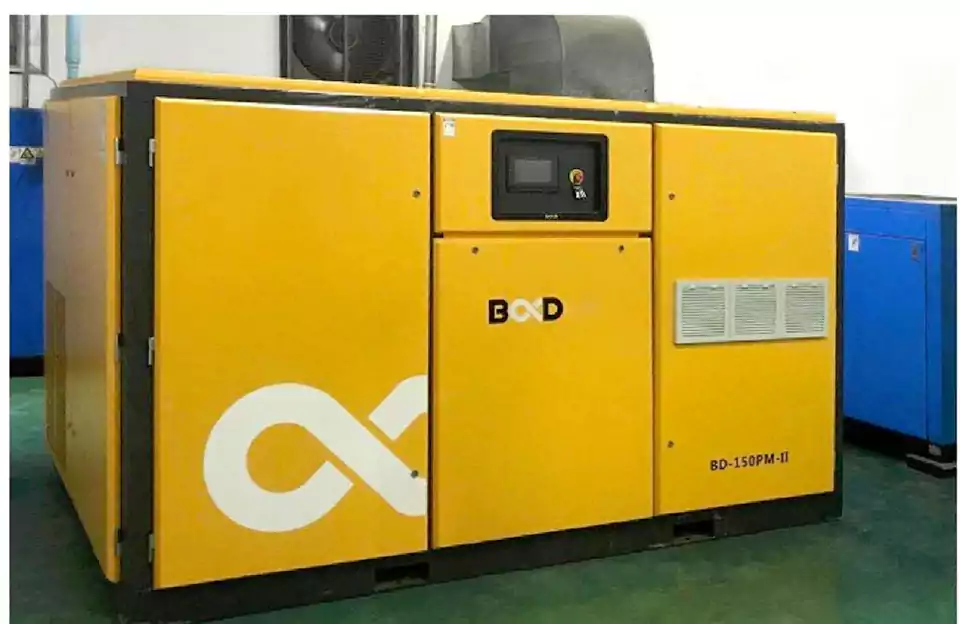
Meta Description: Discover the essential parts of air compressors and learn detailed maintenance tips. Enhance your knowledge with comprehensive diagrams and expert advice for optimal compressor performance.
